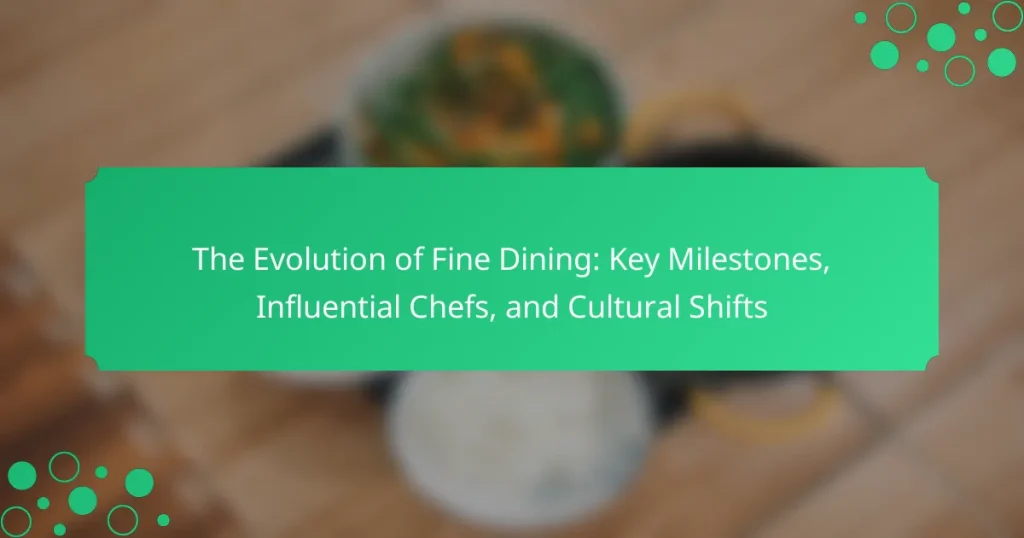The article focuses on the evolution of fine dining, tracing its development from the 18th century to the present day. Initially characterized by formal dining rooms in Europe and elaborate meals, fine dining underwent significant changes influenced by societal shifts, such as the democratization of gourmet food following the French Revolution. The rise of haute cuisine in the 19th century, led by chefs like Auguste Escoffier, modernized culinary techniques and presentation. The 20th century introduced global influences, incorporating diverse cuisines into fine dining, while contemporary practices emphasize sustainability and local sourcing, reflecting current culinary values and trends.
Ferran Adrià is a key figure in the field of molecular gastronomy, a sub-discipline of food science that examines the physical and chemical changes that occur in ingredients during cooking. His innovative techniques, such as spherification and foaming, have redefined traditional culinary methods, allowing for the creation of unique textures and flavors. Adrià’s restaurant, El Bulli, served as a platform for culinary experimentation, emphasizing creativity and artistic expression in food preparation. His influence has led to a significant shift in the culinary landscape, inspiring chefs globally to incorporate scientific principles into their cooking and contributing to the rise of avant-garde dining experiences. The legacy of Adrià’s work continues to shape modern culinary education and restaurant concepts worldwide.

What is the Evolution of Fine Dining?
The evolution of fine dining reflects changes in culinary practices, societal norms, and cultural influences. Initially, fine dining emerged in the 18th century with the establishment of formal dining rooms in Europe. These venues emphasized elaborate meals and service. The French Revolution influenced dining by democratizing access to gourmet food. The 19th century saw the rise of haute cuisine, characterized by intricate dishes and presentation. Influential chefs like Auguste Escoffier modernized kitchen techniques and menus during this period. The 20th century introduced global influences, with diverse cuisines becoming part of fine dining. Today, fine dining incorporates sustainability and local sourcing, reflecting contemporary values.
How has fine dining changed over the decades?
Fine dining has evolved significantly over the decades. In the mid-20th century, it focused on traditional European cuisine and formal service. The 1980s introduced nouvelle cuisine, emphasizing lighter dishes and artistic presentations. By the 1990s, fusion cuisine emerged, blending global flavors and techniques. The rise of celebrity chefs in the 2000s popularized unique dining experiences and innovative menus. Sustainability and farm-to-table practices gained prominence in the 2010s, reflecting a shift towards ethical dining. Today, fine dining often incorporates technology, such as digital menus and interactive experiences. This evolution reflects changing consumer preferences and cultural influences in the culinary world.
What are the key milestones in the history of fine dining?
The key milestones in the history of fine dining include the establishment of haute cuisine in the 18th century. This culinary movement emphasized elaborate presentation and refined techniques. The first restaurant, opened in Paris in 1765 by Boulanger, marked a significant shift towards dining as an experience. The 19th century saw the rise of famous chefs like Escoffier, who codified French cooking methods. The Michelin Guide, first published in 1900, introduced a system for rating restaurants. The post-World War II era brought global influences into fine dining. The emergence of molecular gastronomy in the late 20th century redefined culinary boundaries. Today, fine dining continues to evolve, embracing sustainability and local ingredients.
How have societal changes influenced fine dining practices?
Societal changes have significantly influenced fine dining practices. The rise of health consciousness has led to an increased demand for organic and locally sourced ingredients. This shift reflects a broader societal trend towards sustainability and environmental awareness. Additionally, the growing diversity in culinary traditions has encouraged restaurants to incorporate global flavors and techniques. Social media has transformed how fine dining is marketed and experienced. Platforms like Instagram have made visual presentation crucial for attracting customers. Furthermore, the COVID-19 pandemic has accelerated the adoption of takeout and outdoor dining options. These adaptations showcase the industry’s responsiveness to changing consumer preferences and circumstances.
Who are the influential chefs that shaped fine dining?
Auguste Escoffier, Alice Waters, and Thomas Keller are influential chefs who shaped fine dining. Auguste Escoffier is known as the father of modern French cuisine. He established the kitchen brigade system and standardized recipes. His work laid the foundation for contemporary culinary practices. Alice Waters pioneered the farm-to-table movement. She emphasized fresh, local ingredients in her restaurant, Chez Panisse. Her influence has inspired countless chefs to focus on sustainability. Thomas Keller is renowned for his meticulous attention to detail. His restaurant, The French Laundry, has received multiple Michelin stars. Keller’s approach combines technical skill with a deep respect for ingredients. These chefs collectively transformed fine dining into an art form.
What contributions did iconic chefs make to the culinary world?
Iconic chefs have significantly shaped the culinary world through innovation and influence. They introduced new techniques that transformed cooking methods. For instance, Auguste Escoffier formalized French cuisine, establishing the brigade system in professional kitchens. Julia Child popularized French cooking in America, making it accessible to home cooks. Ferran Adrià revolutionized gastronomy with molecular cuisine, altering perceptions of food structure and flavor. Thomas Keller emphasized precision and quality, elevating fine dining experiences. Alice Waters championed farm-to-table movements, promoting sustainable and organic ingredients. These chefs not only created memorable dishes but also inspired generations of cooks and food enthusiasts globally. Their contributions have led to a richer, more diverse culinary landscape.
How did these chefs innovate traditional cooking methods?
These chefs innovated traditional cooking methods by incorporating modern techniques and technology. They utilized sous-vide cooking, which allows precise temperature control, enhancing flavor and texture. Molecular gastronomy became a hallmark, transforming ingredients into unexpected forms, such as foams and gels. They also embraced local and seasonal ingredients, elevating traditional dishes with fresh flavors. Techniques like fermentation and smoking were reimagined to add depth to classic recipes. Chefs often collaborated with scientists to explore new culinary possibilities. This blending of science and art led to unique dining experiences. Their innovations have reshaped menus and influenced culinary education globally.
What cultural shifts have impacted fine dining?
Cultural shifts impacting fine dining include the rise of sustainability and health consciousness. Consumers increasingly prioritize organic and locally sourced ingredients. This shift has led restaurants to adapt their menus accordingly. Additionally, the casualization of dining experiences has influenced fine dining. Many establishments now offer a more relaxed atmosphere. The influence of global cuisines has also expanded fine dining options. Chefs incorporate diverse flavors and techniques from various cultures. Furthermore, the impact of social media has changed how dining experiences are marketed. Visual appeal and shareability have become essential in attracting patrons. These cultural trends collectively reshape the fine dining landscape.
How have global cuisines influenced the fine dining landscape?
Global cuisines have significantly influenced the fine dining landscape by introducing diverse flavors and techniques. This integration has led to the fusion of culinary traditions. For instance, French cuisine has historically set standards in fine dining. However, Italian, Asian, and Latin American elements have increasingly been incorporated. Renowned chefs, such as Nobu Matsuhisa, have popularized Japanese-Peruvian fusion, enhancing the dining experience. The Michelin Guide now recognizes restaurants that blend these global influences. This trend reflects a growing consumer interest in authentic and innovative flavors. As a result, fine dining continues to evolve, embracing multiculturalism and creativity.
In what ways has technology changed the dining experience?
Technology has significantly transformed the dining experience in various ways. Digital menus allow for easy updates and customization. Contactless payments enhance convenience and speed during transactions. Reservation systems streamline booking processes, reducing wait times. Online reviews influence customer choices and restaurant reputations. Food delivery apps expand dining options beyond traditional restaurant settings. Social media platforms serve as marketing tools, attracting new customers. Virtual reality experiences provide immersive dining environments. Finally, kitchen technology improves food preparation efficiency and consistency. Each of these advancements enhances the overall dining experience for consumers.
What are the connections between milestones and influential chefs?
Milestones in fine dining often coincide with the innovations introduced by influential chefs. For instance, the introduction of nouvelle cuisine in the 1970s marked a significant shift in culinary techniques and presentation. Chefs like Paul Bocuse played a pivotal role in this movement, emphasizing fresh ingredients and artistic plating.
Additionally, milestones such as the establishment of Michelin stars have directly impacted chefs’ careers and restaurant reputations. Chefs like Alain Ducasse have earned multiple Michelin stars, showcasing the connection between their culinary excellence and the recognition of fine dining milestones.
Furthermore, significant events, such as the opening of iconic restaurants, have shaped culinary landscapes. For example, the opening of El Bulli by Ferran Adrià in the 1990s revolutionized molecular gastronomy, marking a milestone in modern cuisine.
These connections illustrate how influential chefs not only respond to milestones but also actively shape them through their creativity and innovation.
How do cultural shifts relate to the evolution of fine dining?
Cultural shifts significantly influence the evolution of fine dining. Changes in societal values, such as health consciousness or sustainability, affect dining preferences. For instance, the rise of farm-to-table practices reflects a growing demand for local and organic ingredients. Additionally, globalization has introduced diverse cuisines into fine dining, broadening culinary horizons. The increasing acceptance of casual dining experiences has led to the emergence of upscale casual restaurants. Historical events, like economic downturns, have also shaped fine dining trends, prompting a shift towards more affordable luxury dining options. These cultural transformations continuously redefine what fine dining means to different communities.
What are the current trends in fine dining today?
Current trends in fine dining include a focus on sustainability and local sourcing. Many restaurants emphasize farm-to-table practices. This approach reduces carbon footprints and supports local economies. Another trend is the incorporation of global flavors and techniques. Chefs experiment with diverse cuisines to create innovative dishes. Plant-based menus are also gaining popularity. Many diners seek vegetarian and vegan options. Additionally, experiential dining is on the rise. Restaurants offer unique atmospheres and interactive experiences. Technology integration, such as digital menus and reservations, is becoming standard. These trends reflect changing consumer preferences and values in the culinary landscape.
How are sustainability and local sourcing shaping modern fine dining?
Sustainability and local sourcing are transforming modern fine dining by prioritizing environmentally friendly practices and fresh ingredients. Chefs are increasingly selecting local produce to reduce carbon footprints. This approach supports local economies and fosters community relationships. Many restaurants now feature seasonal menus that change based on available local ingredients. Research indicates that 70% of diners prefer restaurants that source ingredients locally. Additionally, sustainable practices often include reducing waste and implementing eco-friendly packaging. This shift is not only beneficial for the environment but also enhances the overall dining experience.
What role does presentation play in the dining experience?
Presentation plays a crucial role in the dining experience by influencing perceptions of taste and quality. Visual appeal can enhance anticipation and enjoyment of a meal. Studies show that well-presented dishes are often perceived as more flavorful. According to research published in the journal “Appetite,” people rate food higher when it is visually appealing. Presentation can also reflect the chef’s creativity and skill, adding to the overall dining atmosphere. Aesthetic presentation engages diners and can lead to memorable experiences. Additionally, presentation can convey cultural significance and storytelling through food.
What can diners expect from the future of fine dining?
Diners can expect a more personalized and immersive experience in the future of fine dining. Technology will play a significant role in enhancing customer interactions. Restaurants may incorporate artificial intelligence for tailored menu suggestions. Sustainability will become a central theme, with a focus on locally sourced ingredients. Diners will likely see an increase in plant-based options as health consciousness rises. Interactive dining experiences, such as chef-led cooking classes, may become more common. The atmosphere will emphasize unique themes and storytelling to engage guests. Overall, fine dining will evolve to prioritize both culinary excellence and customer experience.
How might technology further transform the dining experience?
Technology will further transform the dining experience through innovations such as AI, automation, and augmented reality. AI can personalize menu recommendations based on customer preferences. Automation in kitchens can enhance efficiency and consistency in food preparation. Augmented reality can provide immersive dining experiences, allowing diners to visualize dishes before ordering. Mobile apps can streamline reservations and payments, improving customer convenience. Smart tables can offer interactive menus and real-time feedback options. Data analytics can help restaurants optimize inventory and reduce waste. These technological advancements are already being implemented in various establishments, showcasing their potential impact on the dining landscape.
What emerging culinary trends should diners be aware of?
Plant-based cuisine is an emerging culinary trend diners should be aware of. This trend emphasizes the use of vegetables, grains, and legumes as main components of meals. Many restaurants are now offering innovative plant-based dishes that replicate traditional flavors. According to a report by the Good Food Institute, plant-based food sales grew by 27% in 2020. Another trend is the focus on sustainability in sourcing ingredients. Chefs are increasingly prioritizing local and seasonal produce. This shift supports local farmers and reduces carbon footprints. Fermentation is also gaining popularity, enhancing flavors and preserving food. Additionally, global influences are shaping menus, with fusion dishes combining diverse culinary traditions. These trends reflect a broader shift towards health-conscious and environmentally friendly dining experiences.
What tips can enhance the fine dining experience for patrons?
To enhance the fine dining experience for patrons, focus on attentive service and ambiance. Attentive service includes knowledgeable staff who can recommend dishes and wine pairings. Ambiance is created through lighting, music, and table settings that reflect the restaurant’s theme. High-quality ingredients are essential for flavorful dishes. Seasonal menus can provide freshness and variety. Presentation of food should be visually appealing to elevate the dining experience. Reservation systems can minimize wait times and enhance organization. Finally, incorporating unique dining experiences, such as chef’s tables or tasting menus, can create memorable moments for patrons.
The main entity of this article is the evolution of fine dining, which encompasses key milestones, influential chefs, and cultural shifts in culinary practices. The article outlines the historical development of fine dining from the 18th century to the present, highlighting significant changes in cuisine, service, and dining experiences over the decades. It discusses the impact of notable chefs like Auguste Escoffier and Alice Waters, as well as the influence of societal changes, global cuisines, and technological advancements on modern dining. Additionally, the article examines current trends such as sustainability, plant-based menus, and the role of presentation, providing a comprehensive overview of the fine dining landscape today and its future trajectory.




